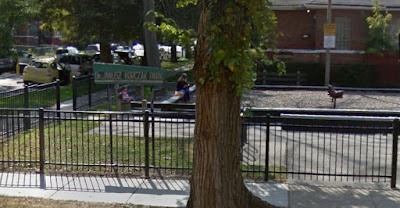We were en route to Sparta, North Carolina. We have studied Sparta and Athens during our formal Classical history studies, but to prepare ourselves for Sparta in North Carolina, we had only to resort to Wikipedia. Unfortunately, the entry is about five sentences long, so that was not very promising. The only interesting piece of the Wikipedia article was that the main character in Thomas Wolfe's book, "I am Charlotte Sims" is from there. I recall having started reading that book when it was published, and I am not entirely convinced that Sparta was described in a very flattering way.
Having low expectations, we all fell asleep in the car, except our trusty driver, and had not the slightest even subconscious inkling of when we passed into Sparta's boundaries. We awoke to find ourselves on a springtime street, quite over-canopied with fresh sunshine, and a tidy, bustling avenue full of interesting shops. As it turns out, this has to count as one of the most family-values, wholesome row of shops I've ever seen, except maybe Diagon Alley and Hogsmeade High Street.
First, there were pretty 'Welcome to Sparta's signs and bike route indicators everywhere.
Then, there were more family values signs like this Community Challenge Quilt (all interested parties can sign up at the local libraries).
And broaden-your-horizons sigs, like this award-winning photographer and journalist giving a talk, also at the Alleghany Public Library. I think when a lot is happening at the local library, that is always a good sign.
As for shops, first they had one full of clothes, also advertising slippers for 50% off, right next door to the Mustard Seed Cafe, whose menu is not one I would be loath to try at all, especially not the milkshakes:
Then there was a pretty pottery shop, all in shades of blue:
And a theater! A theater right on Main Street, with velvet red curtains:
Then the county newspaper. I hope it has a lot of readers:
'Cherish the simple things', says the workmanship of this black bench, in a display window full of other hand-made things:
Then we've got the beautiful, frosted cakes in Kathy's Bakery. Wow!
Ofelia's has got cloth bags and hats:
The Alleghany Jubilee was advertising a square dance, old-fashioned guitars, and a man in overalls:
Ice cream and smoothies at the Vintage Cottage!
The Alleghany Museum was not open (we were there on a Tuesday) but look at all the cool stuff they have on display:


The Little River Gallery was closed, and next to it, the little bookstore was taking down its 'Open' sign. But the lady let me go in anyways. She said I was the second person who had come in all afternoon. All their books are donated, and the staff is also all volunteers, and the proceeds go to the local library. Also, most of their books are only 50 cents. It's great. And they have old books that you don't normally see in bookstores, like The Professor by Charlotte Bronte, and The Work by Louisa May Alcott, and old childen's books about some kid called Tom Swift, and a novel called Tom Jones which I think was written maybe 300 or 400 years ago and is maybe considered the oldest novel written, at least in English. Also, I found 'A Tree Grows in Brooklyn'. This is such a beautiful book, and you really don't find it all the time any more. Plus, I found out a few years ago that the author of that book lived in Chapel Hill in her later life.

The last place I stopped in at was the Visitor's Center. My fellow travelers tried the public restrooms with much dread, but then pronounced them the cleanest bathrooms they'd seen! The Visitor's Center also has a rack with postcards, and the top three rows are all free. So you can write a note to friends and help the post office revenues all at the same time. The only problem is that as you pick out your postcards, the two people sitting at the Visitor's Center desk just stare at you the whole entire time. One of them is an Appalachian State student who proudly told us that he is interning at the Sparta Visitor Center for the summer. However, his rudeness does not recommend him for the job. And the lady sitting behind him was older, and presumedly works here all the time, so I don't know why she was practicing coldness, too. But all they did was stare, the whole time, with wide open eyes.
Sparta is one of the last towns on the North Carolina side of the border before we ventured forth into realms unknown.






















































